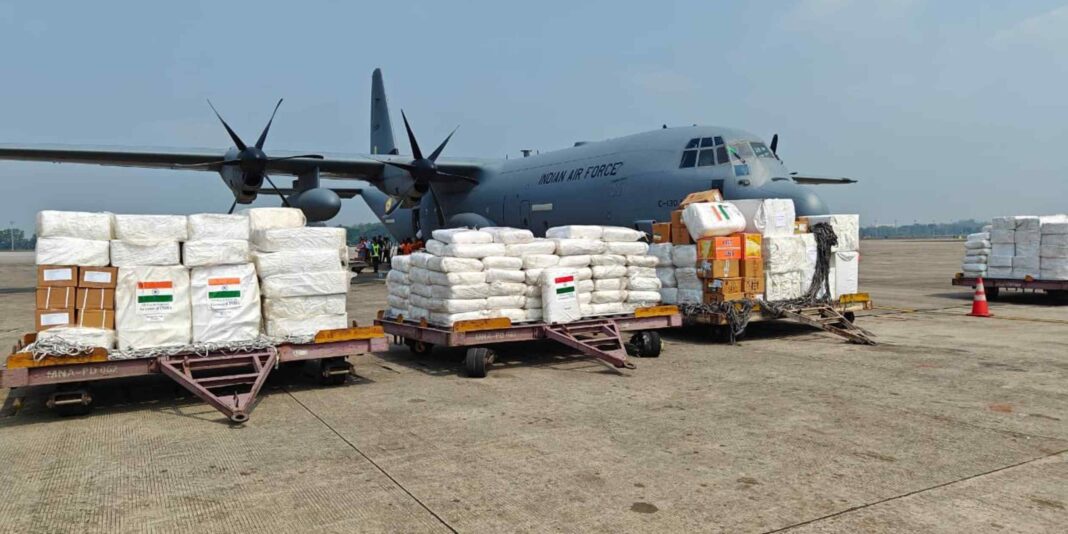BANGKOK — International aid organizations are assessing needs and delivery routes in Myanmar after a 7.7-magnitude earthquake on Friday damaged two major airports and left many roads impassable in a country mired in a 4-year-old civil war that has made transport in many areas extremely dangerous.
A full logistics assessment led by the United Nations World Food Program is underway. But the airport in Naypyitaw, the capital, is assumed unusable by aid groups for commercial flights after the air control tower collapsed during the quake, killing all nine staff. Mandalay airport, close to the epicenter, suffered structural damage. Yangon airport in the south of the country remains operational.
“The responding teams are using land routes to access people in need,” said the U.N. Office for the Coordination of Humanitarian Affairs. “Many of the road ways are impacted, and we are using all resources at our disposal to find ways to deliver life-saving aid to the affected people.”
The U.N. has allocated an initial $5 million for the earthquake response.
The disaster killed at least 1,644 people in Myanmar and injured several thousand, according to the military. A network of civil society organizations said on Sunday night their assessment put it at about 2,500. It comes on top of a protracted humanitarian crisis in the civil war-torn country. The UN estimates that 3 million people had been displaced from their homes and some 20 million were in need of assistance before Friday’s tragedy.
Access is further complicated by the State Administration Council, the official name of the military regime that seized power in 2021, controlling less than half of the country; many of the land borders are in the hands of opposition forces.
The opposition National Unity Government on Saturday announced a two-week offensive ceasefire and promised to cooperate with aid agencies.
However, many roads — already dangerous from conflict between the military regime, the NUG and ethnic armed organizations — were rendered unusable by the quake. Many bridges across rivers have also collapsed.
“Accessing Mandalay is extremely difficult,” said Deepala Mahla, CARE International’s chief humanitarian officer. “There’s a widespread fuel shortage and power outage, affecting communications which we need for effective supply chain management.”
Many humanitarian workers on the ground have also suffered from the earthquake, and reinforcements are needed to respond to the mass tragedy.
“We need visas to be issued for humanitarian teams to get into the country as well. It is still an active conflict zone so we also hope for safe and unfettered access,” said Michelle Cicic, regional head for ECHO, the European Union’s humanitarian aid organization.
The European Commission approved initial funding of 2.5 million euros ($2.7 million) for the Myanmar earthquake response on Friday, with an additional allocation forthcoming, according to Cicic.
India, China and Singapore over the weekend sent ships, convoys of trucks and aircraft full of supplies and personnel.
Thailand, also disrupted by the temblor, sent 55 military personnel to help with relief and rescue efforts.
Bangkok, with gleaming skyscrapers built on what was once swampland, felt the quake particularly hard. As of Sunday evening the Thai capital tallied 18 casualties, mostly from the collapse of a 30-story half-built office tower.
Back in Myanmar, some aid groups are making plans to deliver supplies through alternative land routes, which are familiar to locals in Mandalay, Bago, Naypyitaw and Shan states. With the loss of the control tower in Naypyidaw, the military regime’s base, as well as financial and supply constraints, it may take months for Naypyitaw Airport to be operational again. On Saturday there were also reports of a risk of landslides at the capital’s airport.
“Getting planes in and out depends on a lot of factors. As long as the runway is safe, relief flights can land using manual procedures or mobile air traffic control units,” said Richard Horsey, senior adviser for Myanmar at International Crisis Group.
Relief workers on the ground are drawing on prepositioned stocks for earthquake victims from ongoing programs in Myanmar. “But given the scale of the event and scope, there is a need to send in additional supplies for search and rescue teams and supplies for healthcare, shelter and non-food items,” said ECHO’s Cicic.
Mahla of CARE said it was considering emergency cash disbursements to those affected by the earthquake in Myanmar. “It’s faster, cheaper, addresses many supply chain challenges and is dignified,” she said.
“But of course, the market is also affected” by the quake, Mahla added.
The NUG said on Sunday evening that the lack of electricity was leading to a water shortage. Urban areas were struggling to manage the sheer volume of corpses, it added. The NUG also blamed internet blocks imposed by the military government for limiting access to information.

